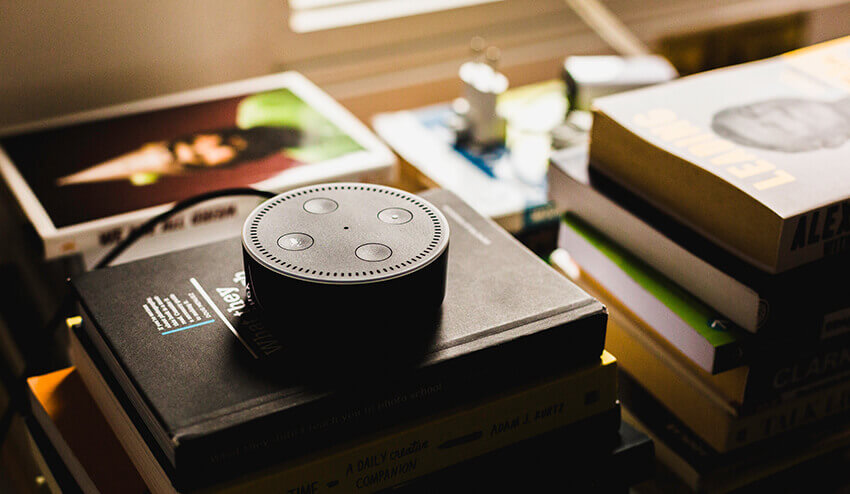There are some technology trends that fizz out over time and then there are the latest technology trends that stay on the sidelines and then gain traction after it either gets major funding or an industry suddenly integrate it in their process.
There are many such technologies that have already made their prominent mark in 2018 and are only a few more applications away from becoming mainstream. Those are the ones that we have listed as the upcoming and latest technology trends that would become trending by the year 2020.
Without further ado, here are the ten technology trends for 2020 –
1. AI
Artificial Intelligence has been continuing to make its place in the list of top technology trends since quite some years. And now has found a place in 2020 technology predictions as well.
Computers are now capable of learning about the world in the same way as us humans. This leap that AI capabilities have been possible because of the enormous increase in computing power and data. It’s this phenomenal explosion in data, which has enabled AI to advance at a lightning speed since the past couple of years; greater the data an AI has, the faster it would be able to learn and more precise it becomes.
The speed at which AI is growing will prepare it to undertake more human tasks by 2020.

Its present-day tasks of enabling computers to read (studying messages and reports), see (through facial recognition), listen (by enabling Amazon Echo to answer your command), speak ( Siri being able to give you an answer) and even record emotions (through affective computing) will help AI become a technology that no longer needs human intervention to aid its learning.
2. NLP
In a year or two, Chatbots would have reached their market potential, with the majority of the businesses employing them to redefine their customer engagement policies. However, by 2020 chatbots would reach a whole different level with the integration of NLP.

Computers, apps, and devices will now be able to understand the true meaning behind what is said. Sarcasm, puns, and double meaning contexts will be clear to the upcoming technologies with the help of NLP.
And users will now be able to ask of things in their natural way of talking and not in words that are “right” for machines and software to understand. The complex algorithms that would go behind it, will be based on millions of computations and predictions that would be generated by mixing AI with all conversations happening between humans and their software/ device.
3. Blockchain
The rate at which Blockchain is growing has placed it at a pivotal point in the list of top technology trends 2020. Blockchain technology is definitely here to stay. While prevalent in only a handful of industries right now, by 2020 the world will see its mass adoption.

A number of new elements and processes will be added in the present day’s most disruptive technology. While there is a fair chance that ICOs won’t stick around that long as might see a fast death because of the stringent regulations.
Cryptocurrencies, the important Blockchain element, will also find itself divided in a number of currencies and would be floated in the market just like fiat currencies. People who are currently unaware of what Blockchain and Cryptocurrencies and where they can spend them, will start doing their everyday transactions with them.
4. IoT
IoT has been finding itself in the list of up and coming technologies to look out for, since the past many years and now again in the list of the year 2020 technologies.
Although it has been a little slow in connecting devices and home with each other for quite some time, the future presents a different story for IoT altogether. Pretty much everything would be made smart in the coming time.

While still a handful, it is projected that by 2020, a quarter of billion cares will get hooked by the internet, making them much smarter.
Our homes that already have a series of smart products such as TVs, water heaters, microwaves, yoga mats, and the voice-enabled personal assistants like Amazon echo, etc. Will find a series of new entries in only a matter of time.
There are already a lot of devices, but the IoT is only getting started. IHS has predicted there’ll be over 75 billion total connected devices by to support the arrival of the technology in 2020.
5. 5G
By the time 2020 comes, the world would be under the spell of fast internet connection and all the various perks that come attached with it.
5g will find its place in the market very soon, bringing with itself benefits such as high internet speed, lower latency, and higher capacities. The benefits that will make it one of the prime future technological trends in 2020 and beyond.

The benefits would make it possible for autonomous vehicles and wireless VR to work with minimal technical hesitancies. The benefit of 5G would be two-fold. Not only would it enrich the user experience by offering higher data rates when we talk by VR or AR, but it will also be much safety favoring, which is where latency point comes in.
But just how fast would 5G be? It is anticipated that when it takes 26 hours for a movie to download in a 3G network, in 5G the time would reduce to 3.6 seconds.
6. Automation
Automation has moved ahead from its involvement in the production lines. There are a number of ways automation will create its presence around us by becoming one the most awaited new technologies of 2020.
From packaging juice boxes to delivering pizza in self-driving vehicles, automation is fast climbing the food chain from doing routine tasks to a lot more complex, decision-making tasks.

Mixed with Robotics, Machine Learning, and Artificial Intelligence, processes across multiple industries like Food and Beverage, Medical, and Customer Service will become further streamlined and automated by the time 2020 hits our doors.
So here were the ten latest technology trends that are going to see mass adoption before we hit 2020. Are you ready for them?
7. RPA catches a second wind:
Robotic Process Automation isn’t new, and is widely considered to be the lowest hanging fruit on the AI tree, but it is nevertheless a very hot topic at every tech and manufacturing conference I have attended in the last eight months. Attended RPA leads the way but as interest and investments continue to grow, and RPA proves itself trustworthy, I believe that 2020 will be a very big year for RPA investments, just as 2019 was with money being poured into companies like Automation Anywhere, UiPath and Blue Prism. Also, enterprise companies like Cisco are already using RPA to help create wiggle room to upskill and augment the value of their existing workforce, and that model is certain to quickly grow into a winning formula. (Smart companies: take note.)
8. Voice
We’ve seen developments in voice technology in the past like Siri, Alexa, and others, but they have often fallen short of human expectation – or are even usefulness in daily life.
Voice is a medium that tends to be organic and free-flowing, something not easily translated into digital technology. As AI and computer learning programs grow in the next decade, expect voice interpreting and voice creating software to move through its current uncanny valley and into a more human-paralleled realm.
In the near future, Voice commands and voice assistants will prove even more useful to our daily lives, muddying the line between the human-technology interface. As these industries’ underlying technology gets better (AI, Voice processing, Machine learning), it will only be propelled into greater technological significance.
In the realm of voice technology, one specific aspect on the cutting edge is Neuro-linguistic programming. Called NLP, this realm of programming would allow computers and systems to understand the true meaning of voice. This new programming language of sorts would give computers an understanding of underlying human tone, sarcasm, pun, and even deeper context clues like double meanings.
9. Analytics
Analytics are playing an increasingly important role in the growth and measurement of companies across the world. Not only can analytics tell you if you’re successful in your market, but they can help you predict where the markets will move next.
Analytics, while seemingly simple on the surface, actually involves a significant amount of data processing to turn large chunks of raw data into something actionable and useful.
With cloud computing, IoT, and big data growing, data is getting murky and clouded. Analytics tools utilizing machine learning will be needed at a far greater extent than currently implemented to make sense of the data, identify issues, and even recommend action.
In essence, analytics is one specialty that AI and machine learning technologies will be particularly useful in. Analytics will be the perfect use case for many of the next decade’s emerging tech.
10. Extended Reality
Extended Reality (XR) is a catch-all term that covers several new and emerging technologies being used to create more immersive digital experiences. More specifically, it refers to virtual, augmented, and mixed reality. Virtual reality (VR) provides a fully digitally immersive experience where you enter a computer-generated world using headsets that blend out the real world. Augmented reality (AR) overlays digital objects onto the real world via smartphone screens or displays (think Snapchat filters). Mixed reality (MR) is an extension of AR, that means users can interact with digital objects placed in the real world (think playing a holographic piano that you have placed into your room via an AR headset).
These technologies have been around for a few years now but have largely been confined to the world of entertainment – with Oculus Rift and Vive headsets providing the current state-of-the-art in videogames, and smartphone features such as camera filters and Pokemon Go-style games providing the most visible examples of AR.
From 2020 expect all of that to change, as businesses get to grips with the wealth of exciting possibilities offered by both current forms of XR. Virtual and augmented reality will become increasingly prevalent for training and simulation, as well as offering new ways to interact with customers.
11. 3D Printing
If your job involves design, you may soon find yourself with a 3-D printer on your desk. The technology creates 3-dimensional objects by adding material, such as plastic, layer-by-layer, based on a computer generated design until an object has been formed.
It allows designers to quickly prototype concepts right at their desks, meaning faster prototype iterations and a better chance they’ll catch design errors earlyon. It also means they can create custom objects — such as prostheses — much cheaper than conventional manufacturing.
Related Articles:
Continue exploring the landscape of product design with these helpful resources:
Internet of Things Information
Learn top technology information click here
I’m looking forward to getting a robot to do all the housework and ironing.
LikeLiked by 5 people
I love the 3D printing section!
LikeLiked by 2 people
Giving details about all those technology of 2020 made me to know how industries is running now
LikeLiked by 3 people
Nice Article
LikeLiked by 2 people
This is so well written, and so wonderful. Thank you so much for this! I’m bookmarking this article.
LikeLiked by 1 person
Reblogged this on The Strategic Sync by Fahim Moledina and commented:
Great post at a high level on some summaries on where technology is moving.
LikeLiked by 2 people
Nice article. The robots will be helpful in future and I’m gonna be lazy . There are so many inventions coming up and I’m excited
LikeLiked by 1 person
This article is well written. According to me technology gets better minute by minute. I can imagine the future with robots I hope it becomes true
LikeLike
Nice article covers details of technology 2020.
LikeLiked by 1 person
Hi! I liked how compelling and captivating this post was! Great writing style and some interesting supporting points😊 I was wondering if you could checkout my new piece on ARTIFICIAL INTELLIGENCE & JOBS OF THE PAST!And I would really appreciate it if you could comment some feedback to improve the writing style. Looking forward to hearing from you. Best wishes! – Kiran
https://kiranninprogress.wordpress.com/2019/12/04/artificial-intelligence-jobs-of-the-past/
LikeLiked by 1 person
Hello..!?
LikeLiked by 1 person
Helped gaining more info
LikeLiked by 1 person
Great article. I write articles on Data Science and Machine Learning. Please check my blog
https://ashutoshtripathi.com/
LikeLiked by 1 person
I too think the 3-D printing aspect of Tech is inspiring and awesome. I saw a video the other day of a company 3-D printing a Rocket. That they were going to send to space. IF we get to a mas 3-D printing of Rockets saving time and energy, the though of making it to, and living on mars is getting more and more feasible.
LikeLiked by 1 person
Reblogged this on All About Writing and more.
LikeLiked by 1 person
This is more helpful for find the Πλαισιο εργασια plaisio computers online.
LikeLiked by 1 person
This is mind blowing; especially in my part of the world where employment is viewed through manual lenses and many of the predictions here would be seen as inimical to the current jobs; forgetting that some of the operations we relied on just recently are resting in peace, and there are newer jobs. Nice article.
LikeLiked by 1 person
Very informative
LikeLiked by 1 person
Great post, love the blockchain component!
LikeLiked by 1 person
Great post. I think you have it 100% correct and I see the evidence in the market through my customer engagements.
LikeLiked by 1 person
Hey,
How you doing? I really like the way you write this “Simpliv LLC”. Thanks for the informative post, I learned a lot from your article. Boost Up!
Regards
LikeLiked by 1 person